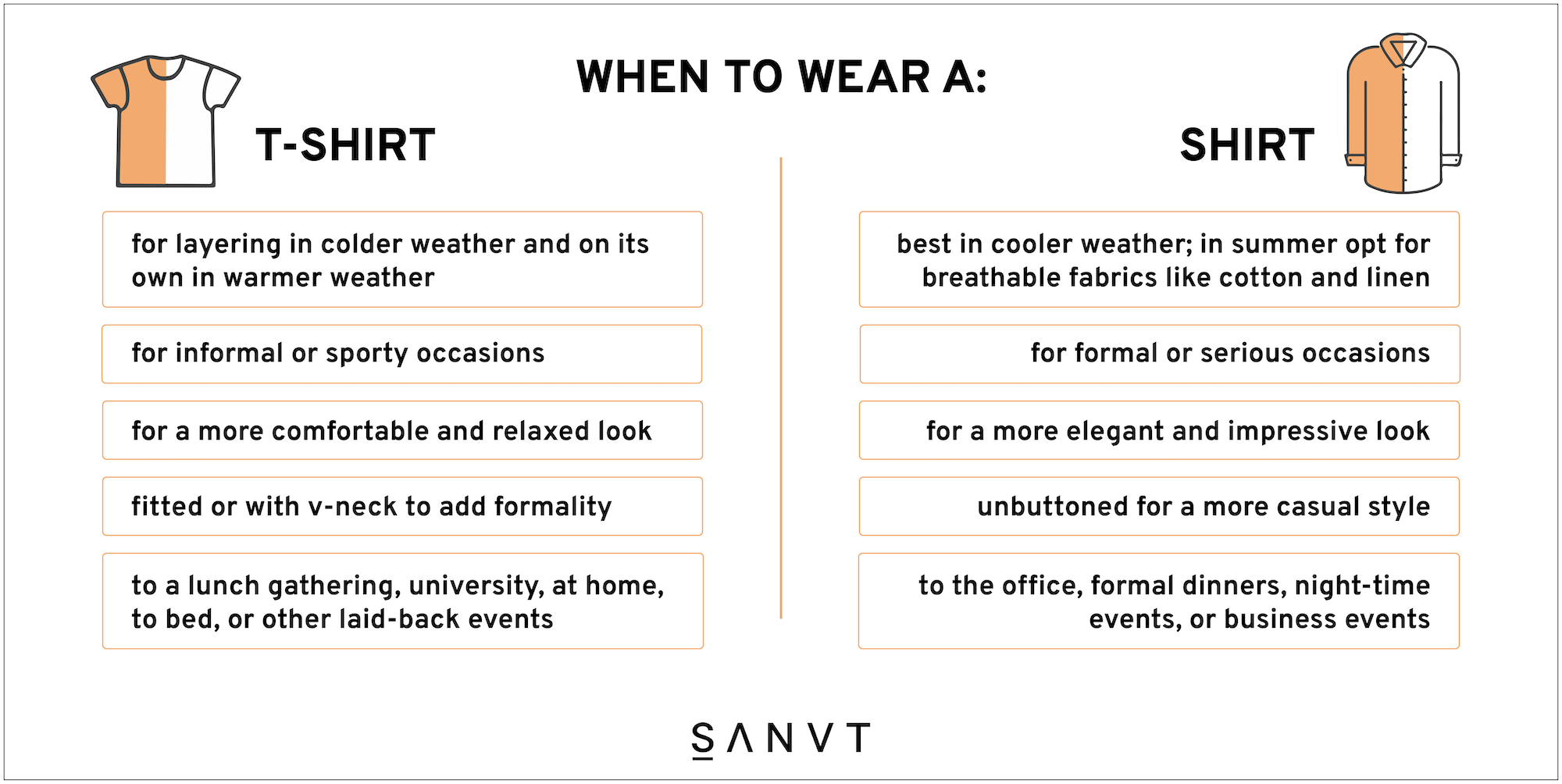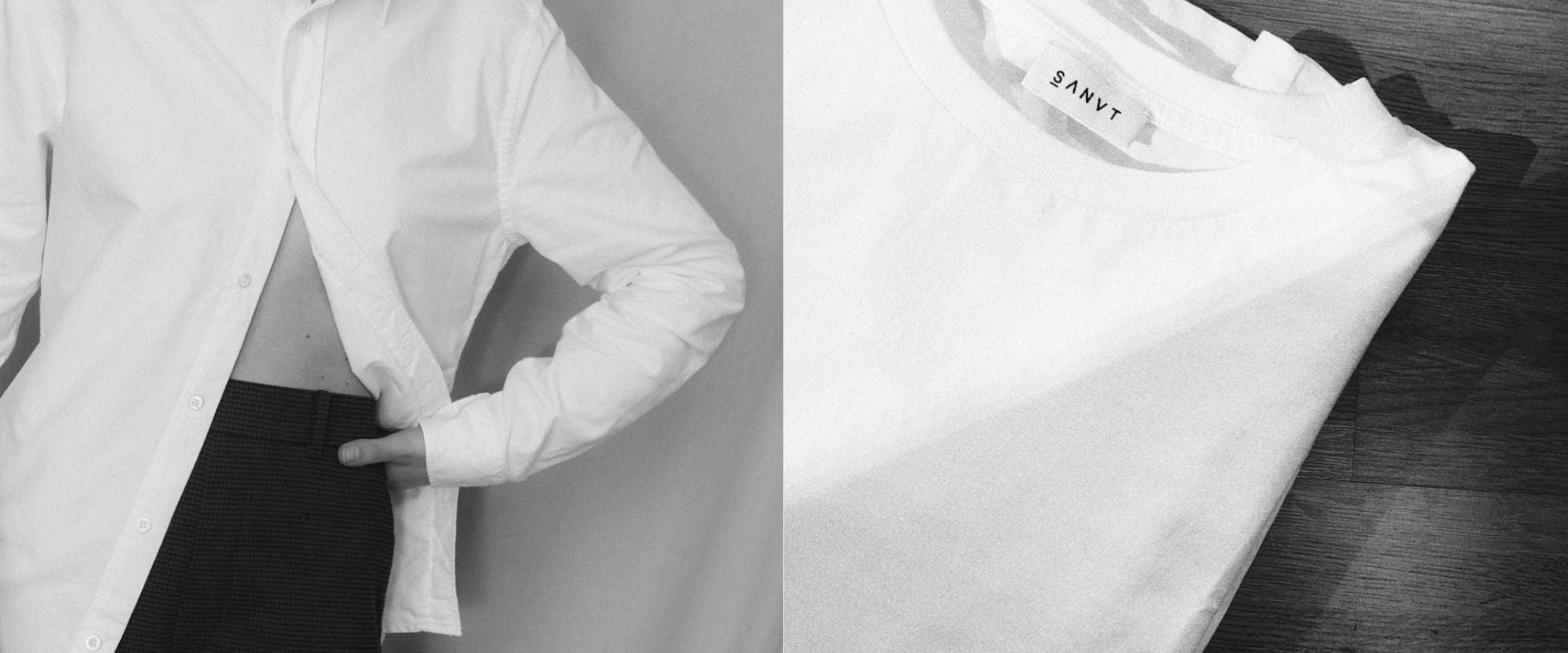T-shirts and shirts are some of the most worn clothing items among men and women. Having been worn since the late 19th century, you can imagine there’s a crazy amount of variety in these garments. But they have some clear differences and can easily be told apart. At SANVT, we’ll break it all down.
T-shirts vs shirts: an overview
- T-shirts do not have collars or buttons; shirts have collars and buttons
- T-shirts are often informal and casual; shirts are somewhat more formal
- T-shirts are typically made of cotton or polyester; shirts come in more diverse fabrics
- T-shirts and shirts can both be short-sleeved or long-sleeved
- T-shirts are most typically short sleeved, shirts long-sleeved.
- Both T-shirts and shirts can suit the summer, depending on GSM.

SANVT’s Perfect T-Shirt and Perfect Oxford Shirt: side by side
T-shirts
The T-shirt got its name from the shape of the letter ‘T’. It’s commonly worn by any gender, and is typically worn for informal, day-to-day occasions due to its comfort. The most commonly used fabrics to make tees are cotton or polyester but these days you’ll notice nicher fabrics being used to make more T-shirts, like linen, rayon, hemp and even Lyocell.
T-shirts can also be worn for semi-formal occasions but, unless you’re audacious or famous, it’s hard to get away with formal. They can be worn at home, to bed, for a lunch gathering, to get a drink with friends, or to university. Pretty much any informal occasion is ok then.
The different types of T-shirts are almost limitless. They can be short-sleeved or long-sleeved, and they can either have patterns or graphics or stay plain. They can also have different types of necklines, such as V-neck, crew neck, scoop neck, and more. Tees can also come in different lengths - for example, cropped T-shirts and extra long T-shirts have both been at the top of the most trending clothing items in recent years. Oversized t-shirts are also having a bit of a moment and can be super stylish.
Here’s another post that goes into some more about the history of the t-shirt.
The Perfect T-Shirt in 185 GSM worn by Light Hunters & Bola
The Perfect T-Shirt
Here at SANVT, we’ve designed the ‘perfect T-shirt’. And part of the reason why we’ve boldly classified it as perfect, is the fabric. As mentioned, polyester is one of the most widely used fabrics to create T-shirts. But we like to go the extra mile for the planet. And since the plastic of polyester is unnecessary to create a high-quality T-shirt - and also leaks microplastics into our oceans when washed - this T-shirt is made 100% from the highest grade single source extra-long staple cotton. The cotton fibres we use are also extremely soft, yet strong and resilient.
Because of the fabric and the longevity, It’s a super sustainable option but it will also fit you perfectly as you can adjust SANVT’s tees by both length and width. What a liberty!
SANVT’s collection includes a variety of other T-shirts, in different weights for different seasons. See here for all the T-shirts we offer for women and men. And now to shirts…
Shirts
First things first, and just in case, shirts are mainly long-sleeved compared to T-shirts’ short sleeves. That said, you do of course get short sleeved shirts in which case the main difference with T-shirts is the collar and front opening with buttons.
Shirts are worn to more formal occasions. They’re worn to the office, to formal dinners and other night-time events, or clubs. But they can also be dressed down for a casual look, for example by wearing an opened shirt over a T-shirt. Likewise, they can be made even more formal by dressing up with a tie. The fabrics often used for shirts are more diverse - they can be made from cotton, linen, wool, silk, poplin, polyester, or blends. And like t-shirts, there are emerging fabrics that are becoming more popular to make shirts with.
Shirts can also come in an abundance of different styles, patterns, and colors. They can be styled in a countless number of ways: tucked in or out, opened or buttoned, partly buttoned or fully buttoned, with sleeves rolled up or not, with a blazer or not - we can go on, but let’s not bore you.
The Perfect Oxford Shirt in 100% organic cotton worn by Dave Vendetta & Denzel Van Tilburg
The Perfect Oxford Shirt
To make our ‘perfect’ shirt, we decided to go with the fabric Oxford because of its versatility. Needless to say, like SANVT’s perfect T-shirt, our Oxford shirt is 100% natural and plastic-free. It’s made entirely from extra-fine organic cotton, and ensures breathability, durability, and softness - perfect for most occasions and classified as an ‘all-rounder’. The only place we wouldn’t recommend it is extremely formal events, like weddings.
The shirt is unisex so can be worn well by both women and men.
T-shirts vs. shirts in the summer
The Perfect Oxford Shirt (191 GSM), worn with sleeves rolled up and The Perfect T-Shirt (185GSM).
Both T-shirts and shirts can serve you well in sunnier conditions. T-shirts by nature, of course, and shirts with sleeves rolled-up, as you wish. Yet, with both T-shirts and shirts there’s an extra to consider and that’s the GSM of the fabric.
GSM stands for grams per square meter, which is a metric that essentially says how thick the fabric is. Here’s a rough guide, depending on the conditions:
- Heavyweight - best for the cold: +200GSM.
- Middleweight - best for most conditions: 160-200GSM.
- Lightweight - best for very hot, or scorching days: 160GSM or under.
Both our Perfect Oxford Shirt and T-Shirt fall in the middleweight range - at 191 and 185 GSM respectively. Both will serve you well when the weather is fairly good. Think of a lovely spring day or a nice typical summer day in northern Europe.
For those sweltering hot days that are becoming a bit more frequent, you might want to check out our lightweight t-shirt, which is a refreshing 160GSM.
T-shirts vs. shirts: the bottom line

Hopefully that cleared up any doubts you had between a T-shirt and a shirt! If you’re looking to excel your knowledge on T-shirts even further, we’ve clarified the difference between a T-shirt and a polo shirt, the difference between heavyweight and lightweight T-shirts, analysed the best T-shirt material, and well - if you’ve got any more doubts after that, you’re on your own! Kidding - feel free to contact us with any questions you have.




